
Grande Montagne Nature Reserve is a 20 ha nature reserve on the island of Rodrigues, preserving one of the last remnants of the island's endemic forest. [1]

Grande Montagne Nature Reserve is a 20 ha nature reserve on the island of Rodrigues, preserving one of the last remnants of the island's endemic forest. [1]

It is located in the high Grand Montagne mountains, in the central eastern part of Rodrigues.
The reserve includes an education and information centre, remains of the extinct Solitaire and giant tortoise species, and the only remaining endemic species of the island - the Rodrigues Fruit Bat ( Pteropus rodricensis ), Rodrigues Fody ( Foudia flavicans ) and Rodrigues Warbler ( Acrocephalus rodericanus ).
It has several viewing points over the eastern part of the island, and a wide range of rare endemic plants. The reserve is also the only remaining habitat of the endemic Rodrigues Aloe ( Aloe lomatophylloides ).

The reserve is run by the national NGO, the Mauritian Wildlife Foundation (MWF). The MWF and the Rodrigues Forestry Services have been conducting restoration work in the reserve since the 1980s.
The visitor is now able to enjoy areas of maturing forest while witnessing other more recently restored areas or view restoration underway. Around 84% of the 25.5 ha fenced area at Grande Montagne has been restored to date and the aim of MWF is to complete the initial restoration of this reserve within the next few years.
Over 156,516 plants have been planted in the reserve by MWF so far and 40 rare Rodriguan plant species are successfully conserved on Grande Montagne. The forest is a habitat to the surviving endemic animals and insects of Rodrigues. From about only 30 birds, the population of the Rodrigues Fody reached 8,000 individuals in 2010, whilst that of the Rodrigues Warbler increased to over 4,000 individuals over the same period, in part due to the habitat restoration on Grande Montagne.

This project involves the local community, providing employment to restoration labourers from the nearby villages and organising ‘restoration working days’ with grassroots associations to sensitise and empower the local people in habitat restoration. The reserve is included in the Rodrigues Environmental Education Programme where students visit and are taught about the reserve and its importance. The reserve is also open to the public for visits, and in 2013 the Rodrigues Regional Assembly approved plans for the MWF to conduct ecotourism activities in this nature reserve.
It runs guided tours and the routes through the reserve contain information signs. [2] [3] [4]
This is an index of conservation topics. It is an alphabetical index of articles relating to conservation biology and conservation of the natural environment.

The Mascarene Islands or Mascarenes or Mascarenhas Archipelago is a group of islands in the Indian Ocean east of Madagascar consisting of islands belonging to the Republic of Mauritius as well as the French department of La Réunion. Their name derives from the Portuguese navigator Pedro Mascarenhas, who first visited them in April 1512. The islands share a common geological origin beneath the Mascarene Plateau known as the Mauritia microcontinent which was a Precambrian microcontinent situated between India and Madagascar until their separation about 70 million years ago. They form a distinct ecoregion with unique biodiversity and endemism of flora and fauna.
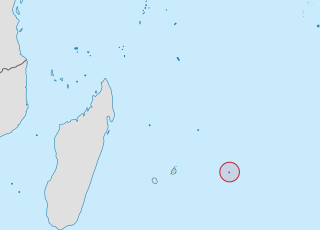
Rodrigues is a 108 km2 (42 sq mi) autonomous outer island of the Republic of Mauritius in the Indian Ocean, about 560 km (350 mi) east of Mauritius. It is part of the Mascarene Islands, which include Mauritius and Réunion. Like Agaléga, Rodrigues is a constituent island of the Republic of Mauritius, under the Constitution of Mauritius and still remains, as explicitly defined by the same Constitution, part of the Sovereignty of Mauritius, together with the following islands: "Agalega, Tromelin, Cargados Carajos, Chagos Archipelago ... Diego Garcia and other islands included in the State of Mauritius".
The Mauritian Wildlife Foundation (MWF) is an independent, non-governmental, non-profit conservation agency working in Mauritius and the Outer Islands to save threatened endemic local flora and fauna.

Danum Valley Conservation Area is a 438 square kilometres tract of relatively undisturbed lowland dipterocarp forest in Sabah, Malaysia. It has an extensive diversity of tropical flora and fauna, including such species as the rare Bornean orangutans, gibbons, mousedeer, clouded leopards and over 270 bird species. Activities offered are jungle treks, river swimming, bird watching, night jungle tours and excursions to nearby logging sites and timber mills.

Round Island is an uninhabited islet 22.5 kilometres north of Mauritius. It has an area of 1.69 square kilometres and a maximum elevation of 280 metres. The island has been a nature reserve since 1957 and is administered jointly by the National Parks and Conservation Service and the Mauritian Wildlife Foundation. The island has been designated an Important Bird Area (IBA) by BirdLife International.
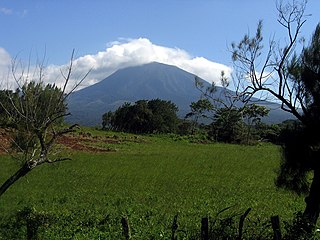
Guanacaste Conservation Area is an administrative area which is managed by the Sistema Nacional de Areas de Conservacion (SINAC) of Costa Rica for conservation in the northwestern part of Costa Rica. It contains three national parks, as well as wildlife refuges and other nature reserves. The area contains the Area de Conservación Guanacaste World Heritage Site, which comprises four areas.
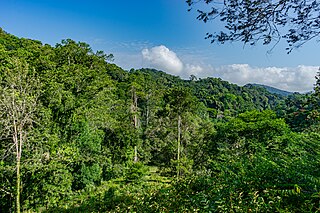
The Amani Forest Reserve, officially listed as Amani Nature Forest Reserve is a protected area located the Muheza and Korogwe Districts in the Tanga Region of Tanzania. The nature reserve was established in 1997 in order to preserve the unique flora and fauna of the East Usambara Mountains. The East and West Usambara Mountains are a biodiversity hotspot. The Amani Nature Reserve includes tropical cloud forest habitats.
Cousine Island is a small granitic island 30 ha in the Seychelles 6 km (4 mi) west of Praslin Island. It is a combination luxury resort and since 1992 a nature preserve.
The wildlife of Mauritius consists of its flora and fauna. Mauritius is located in the Indian Ocean to the east of Madagascar. Due to its isolation, it has a relatively low diversity of wildlife; however, a high proportion of these are endemic species occurring nowhere else in the world. Many of these are now threatened with extinction because of human activities including habitat destruction and the introduction of non-native species. Some have already become extinct, most famously the dodo which disappeared in the 17th century.

The Rodrigues fody is a rare species of bird in the weaver family. It is endemic to Rodrigues, an island of Mauritius. It is classified by BirdLife International as being vulnerable. It is also on the United States' Endangered Species List with an endangered status.

The Montagne des Français Reserve is a protected area consisting principally of dry deciduous forest in northern Madagascar. It is part of the larger Ramena protected area complex which also includes Orangea Reserve and the Ambodivahibe Marine Reserve. These three protected areas are currently being created and will be designated in 2008.
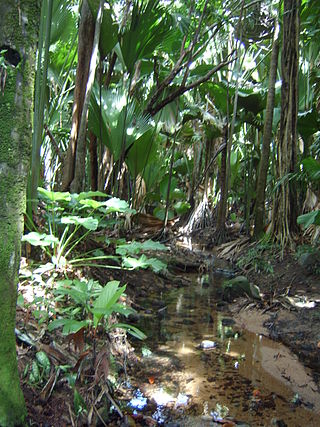
The wildlife of Seychelles comprises the flora and fauna of the Seychelles islands off the eastern coast of Africa in the western Indian Ocean.

The Palos Verdes Peninsula Land Conservancy (PVPLC) is a non-profit organization that is based on the Palos Verdes Peninsula in southwestern Los Angeles County, California.

Many areas of Vietnam are under protection. While the national reserves cover small areas of scientific significance with restricted access, the national parks also cover wetlands of Ramsar designated areas and BirdLife International inscribed bird areas. The largest of the national parks initially covered were the Cúc Phương National Park, the Cát Tiên National Park, and the Côn Đảo National Park which to start with were forest areas cum reserves or prohibited areas. The objective for creating national parks was to allow access to the reserved areas as a part of ecotourism and cultural needs with full attention to the basic approach of conservation of natural environmental resources.

Aloe lomatophylloides is a unique species of Aloe endemic to the island of Rodrigues, in the Indian Ocean. It is part of a group of aloes which bear fleshy berries, and were therefore classed as a separate group, Aloe section Lomatophyllum.

Ile aux Aigrettes is an islet off the south-east coast of Mauritius. It functions as a nature reserve and a scientific research station. It is also a popular visitors attraction — both for tourists and for Mauritians.

François Leguat Giant Tortoise and Cave Reserve is a park and nature reserve on the island of Rodrigues, dedicated to protecting the fauna and flora of the island. The reserve first opened in August 2007, part of the same project as La Vanille Reserve in Mauritius. It is named after the 18th century Huguenot settler François Leguat, who recorded much of the island's natural flora and fauna before it went extinct. The reserve includes a museum, several education centres and information areas, and a restaurant.
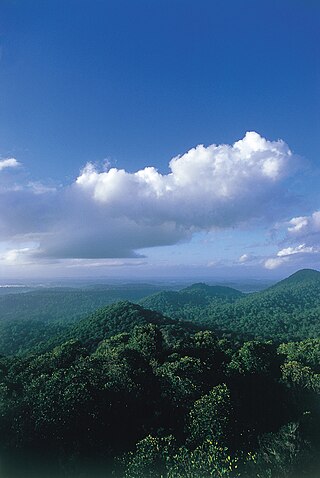
The Petites Montagnes Tortue Biological Reserve is a wilderness area in French Guiana, France. Petites Montagnes Tortue is located about six kilometres from Régina. It is a mountain range rich in quartz and quartzites with a summit of 287 metres (942 ft). The mountains are home to a diverse flora and fauna with about 20 species which are rare or endemic.

The Forests of Mayotte National Nature Reserve is a protected area on Mayotte, an island overseas department of France in the Indian Ocean.